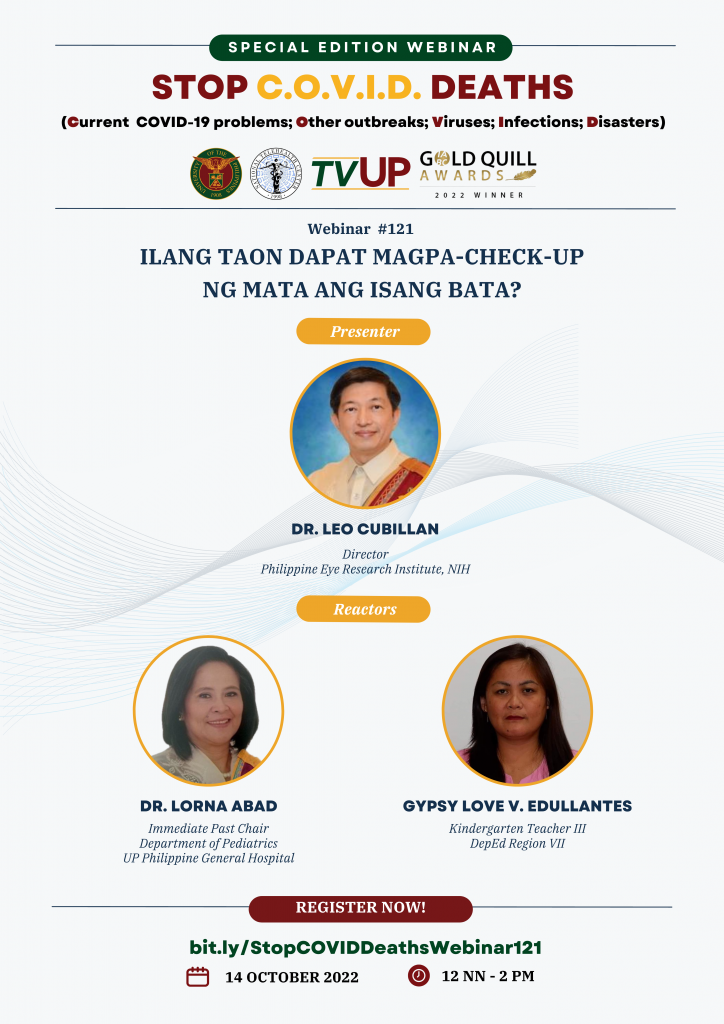
- This event has passed.
Stop COVID Deaths Webinar #121 “Ilang taon dapat magpa-check-up ng mata ang isang bata?”

The University of the Philippines in partnership with
UP Manila NIH National Telehealth Center and in cooperation with
UP Philippine General Hospital
would like to invite you to join the Fight Against COVID-19!
Registration slots are limited to this SPECIAL EDITION of
the STOP C.O.V.I.D. DEATHS Webinar Series.
(Current COVID-19 problems; Other outbreaks; Viruses; Infections; Disasters)
So sign up NOW:
bit.ly/StopCOVIDDeathsWebinar121
Webinar #121
October 14, 2022 (Friday) 12nn
“Ilang taon dapat magpa-check-up ng mata ang isang bata?”
Presenter:
Dr. Leo Cubillan
Director, Philippine Eye Research Institute
National Institutes of Health
Reactors:
Dr. Lorna Abad
Immediate Past Chair, Department of Pediatrics
UP Philippine General Hospital
Gypsy Love V. Edullantes
Kindergarten Teacher III
DepEd Region VII
Synthesis and Closing Remarks:
Dr. Dionne Sacdalan
PGH Coordinator for Training
UP Philippine General Hospital
———————————————————–
Webinar #121
October 14, 2022 (Friday) 12nn
“Ilang taon dapat magpa-check-up ng mata ang isang bata?”
Our eyes play a very important role in the quality of our lives. If we are living with an error of refraction and do not know it, our quality of life is compromised and we may be unable to reach our full potential including our ability to learn, work, play and live safely.
According to the World Health Organization, globally at least 2.2 billion people have a near or distance vision impairment. In at least 1 billion – or almost half – of these cases, vision impairment could have been prevented or has yet to be addressed. The leading causes of vision impairment and blindness are uncorrected refractive errors and cataracts.
Myopia (or near-sightenedness) is the most common ocular disorder worldwide, it is the leading cause of visual impairment in children, and its incidence is increasing rapidly. Early diagnosis and corrective lenses is not available to many children who live in disadvantaged settings both in developed and developing countries. Myopia is a major public health concern in many East Asian countries, where the condition affects 80% to 90% of high school graduates. Of these individuals, 10% to 20% have sight-threatening pathologic myopia. Singapore and Taiwan report the highest rates of myopia – affecting 80-90% of the general population. In the Philippines, the national average is about 10%, but in disadvantaged urban areas, it is as high as 20-30%.
Why is myopia increasing? Genetics is usually blamed for the rise in myopia, but recent studies are pointing to the lack of exposure to natural light as a risk factor. Gadgets like computers, pads, and mobile phones consume a lot of time, with less time outdoors in natural light. How soon should visual acuity screening start? What are possible signs and symptoms of visual acuity problems?
Our main presenter is Dr. Leo Cubillian, Director of the Philippine Eye Research Institute, National Institutes of Health, who will walk us through an important project to start visual acuity studies early. We will also be joined by Dr. Lorna Abad, Immediate Past Chair of the Department of Pediatrics at the UP Philippine General Hospital, and Gypsy Love V. Edullantes, Kindergarten Teacher III with DepEd Region VII. The Synthesis and Closing Remarks will be delivered by PGH Coordinator for Training at UP Philippine General Hospital, Dr. Dionne Sacdalan.
Join us as we discuss eye health – and the need to screen for visual acuity sooner rather than later. See you online! Together, we can STOP C.O.V.I.D. DEATHS!
